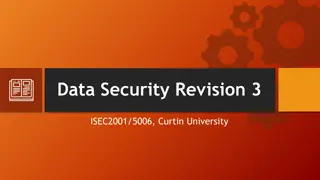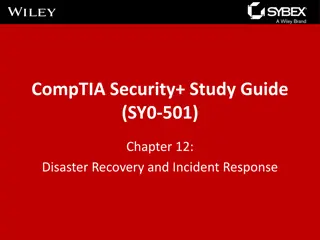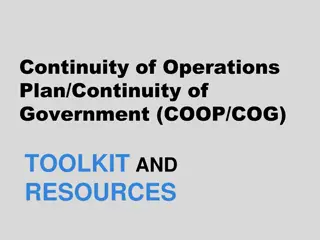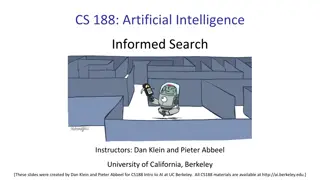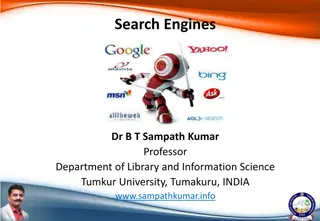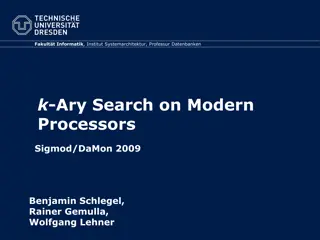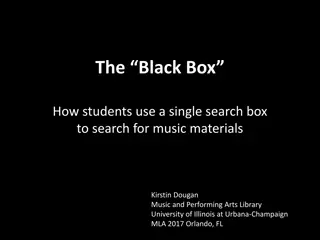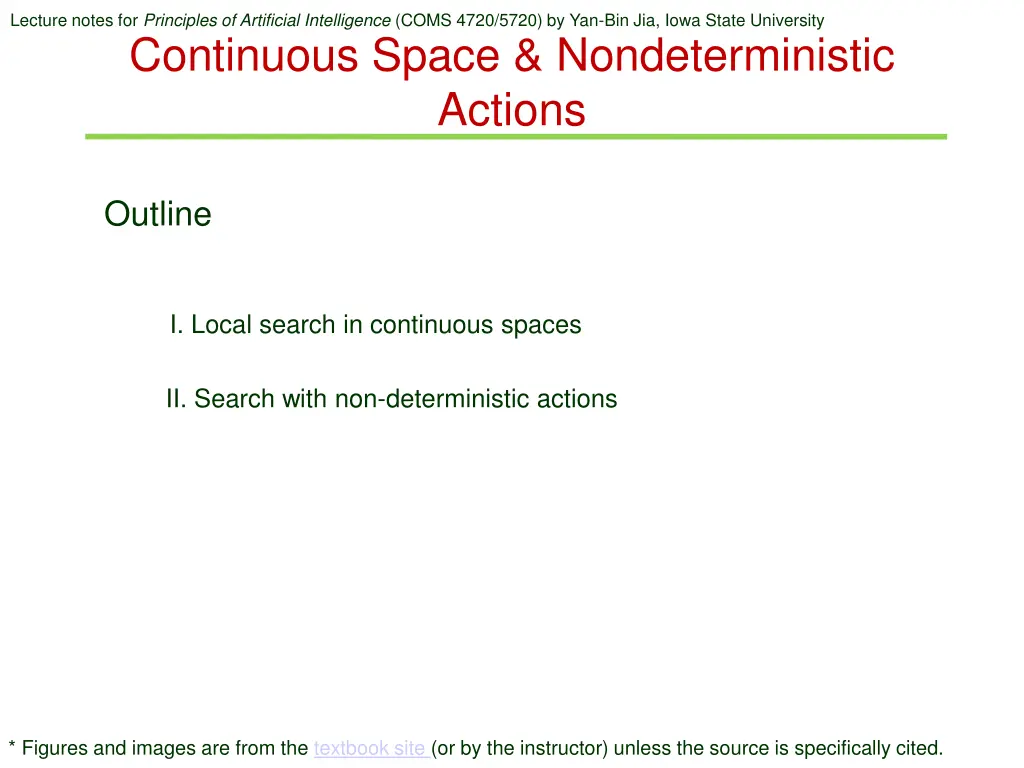
Principles of Artificial Intelligence Lecture Notes on Continuous Space & Nondeterministic Actions
Explore lecture notes from COMS 4720/5720 at Iowa State University covering topics such as local search in continuous spaces, search with non-deterministic actions, gradient-based methods, Newton-Raphson method, and more in the context of artificial intelligence principles.
Download Presentation

Please find below an Image/Link to download the presentation.
The content on the website is provided AS IS for your information and personal use only. It may not be sold, licensed, or shared on other websites without obtaining consent from the author. If you encounter any issues during the download, it is possible that the publisher has removed the file from their server.
You are allowed to download the files provided on this website for personal or commercial use, subject to the condition that they are used lawfully. All files are the property of their respective owners.
The content on the website is provided AS IS for your information and personal use only. It may not be sold, licensed, or shared on other websites without obtaining consent from the author.
E N D
Presentation Transcript
Lecture notes for Principles of Artificial Intelligence (COMS 4720/5720) by Yan-Bin Jia, Iowa State University Continuous Space & Nondeterministic Actions Outline I. Local search in continuous spaces II. Search with non-deterministic actions * Figures and images are from the textbook site (or by the instructor) unless the source is specifically cited.
I. Local Search in Continuous Space Problem Place three new airports anywhere in Romania to minimize the sum of square straight-line distances from every city to its nearest airport. Airport locations: (?1,?1), (?2,?2), (?3,?3) ?1 ?3 State? = (?1,?1,?2,?2,?3,?3) ??: set of cities to which airport ? is the closest, for 1 ? 3. Depends on ?. Objective function: (?3,?3) (?1,?1) (?2,?2) ?2 ? ? = ? ?1,?1,?2,?2,?3,?3 3 Voronoi diagram 2+ ?? ?? 2 = ?? ?? min ? ?(?) ?=1 ? ??(?)
Gradient-Based Method ?? ??1 ,?? ??2, ,?? Use the gradient: ?(?1, ,??) = ??? direction of fastest increase in ? value locally ?: direction of fastest decrease in ? value locally ? ?,? = cos2? + cos2?2 Gradient map * From https://en.wikipedia.org/wiki/Gradient
Gradient Descent Back to airport placements: ?? ??1 ,?? ??1,?? ??2,?? ??2,?? ??3,?? ? = ??3 3 ?? ??1 2+ ?? ?? 2 ? ? = ?? ?? = 2 ?1 ?? ?=1 ? ??(?) ? ?1 Update: ? ? ? ?(?) step size
Line Search 1. Start at an initial state ? = ?0. 2. Move along ?(?) until ? no longer decreases. 3. ? new stopping point. 4. Go back to step 2 ... ?(?0) ?1 ?(?1) ?0 Steepest descent (along ?) ? ?,? = ?4 ? ?,? = ?3 ?1> ?2> ?3> ?4 ? ?,? = ?2 (level curve) ? ?,? = ?1
Newton-Raphson Method Solve ? ? = 0 // one variable with the iteration formula ? = ?(?) ? ? ?(?) ? (?) ? ?(?) ? (?) ? To maximize/minimize ?(?), find ? at which ? ? = ?. Iteration formula: 1(?) ?(?)? ? ? ?? Newton s monument (& sarcophagus) Westminster Abbey, London, UK ?2? ?????? Hessian ?? of ?: matrix
More on Continuous Optimization Com S 4770/5770 covers more topics: Unconstrained nonlinear optimization: https://faculty.sites.iastate.edu/jia/files/inline-files/nonlinear-program.pdf Constrained nonlinear optimization (Lagrange multipliers): https://faculty.sites.iastate.edu/jia/files/inline-files/lagrange-multiplier.pdf https://faculty.sites.iastate.edu/jia/files/inline-files/lagrange-multiplier.pdf Linear programming (i.e., linear optimization under linear constraints) https://faculty.sites.iastate.edu/jia/files/inline-files/linear-program.pdf https://faculty.sites.iastate.edu/jia/files/inline-files/simplex.pdf
II. Nondeterministic Actions The agent may not know the next state after taking an action in a nondeterministic environment. A belief state is a set of physical states believed to be possible by the agent. Problem solution: a conditional plan. To specify what to do depending on what percepts the agent receives while executing the plan.
Perfect Vacuum World Fully observable, deterministic, and completely known Solution: Suck, Right, Suck 8 possible states
Erratic Vacuum World Suck: Applied to a dirty square clean the square sometimes clean up dirt in an adjacent square Applied to a clean square sometimes deposit dirt on the carpet Either state 5 or 7 after applied to state 1: RESULTS(1, Suck) = {5, 7} RESULTS(8, Suck) = {6, 8}
Suck: Applied to a dirty square clean the square sometimes clean up dirt in an adjacent square Still Solvable? No single sequence of actions solves the problem. Solution still exists as a conditional plan (suppose at State 1): [Suck, if State = 5 then [Right, Suck]else[]] Solution is a tree of a different character!
Suck: Applied to a dirty square clean the square sometimes clean up dirt in an adjacent square Applied to a clean square sometimes deposit dirt on the carpet AND-OR Search Tree OR-node (deterministic): the agent chooses an action. e.g., Left, Right, or Suck AND-node (non-deterministic): the environment chooses to have an outcome for each action. e.g., Suck in state 1 results in the belief state {5, 7}. OR- and AND-nodes alternate in the tree.
Example of a (Partial) Tree A solution is a connected portion of the AND-OR tree such that its root is the tree s root; every OR node has exactly one child (i.e., one of the actions); every AND node has all children (possible outcomes) from the corresponding action; all the leaves are goal nodes.
DFS Implementation of AND-OR Tree Search ?1,?2, ,?? ?0 // ignore a solution with a cycle. such a solution would // imply the existence of a non-cyclic solution // which can // be found. // one action eventually leads // to a solution; terminates successfully. ?? ?1,?2, ,?? // one state has no solution; fails to solve the problem. ?0 ?1 ?? ?? Solution plan ?1 ?? ?2
Cyclic Plan for a Solution What if an action fails and the state is not changed? Slippery vacuum world. Right State 1 {1,2} Right State 5 {5,6} Cyclic solution do Suck; if State = 5 then Right The goal will be reached provided that each outcome of a nondeterministic action eventually occurs.


